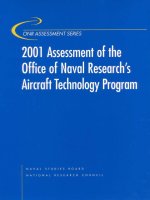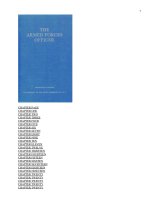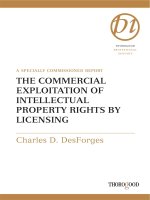The Eyes of the Fleet - An Analysis of the E-2C Aircraft Acquisition Options docx
Bạn đang xem bản rút gọn của tài liệu. Xem và tải ngay bản đầy đủ của tài liệu tại đây (341.36 KB, 107 trang )
The Eyes of
the Fleet
An Analysis of the E-2C Aircraft
Acquisition Options
Obaid Younossi
Mark V. Arena
Michael Boito
Jim Dryden
Jerry Sollinger
Prepared for the
United States Navy
Approved for public release; distribution unlimited
R
NATIONAL DEFENSE RESEARCH INSTITUTE
The research described in this report was sponsored by the Office of
the Secretary of Defense (OSD). The research was conducted in
RAND’s National Defense Research Institute, a federally funded
research and development center supported by the OSD, the Joint
Staff, the unified commands, and the defense agencies under
Contract DASW01-01-C-0004.
RAND is a nonprofit institution that helps improve policy and
decisionmaking through research and analysis. RAND
®
is a
registered trademark. RAND’s publications do not necessarily reflect
the opinions or policies of its research sponsors.
© Copyright 2002 RAND
All rights reserved. No part of this book may be reproduced in any
form by any electronic or mechanical means (including
photocopying, recording, or information storage and retrieval)
without permission in writing from RAND.
Published 2002 by RAND
1700 Main Street, P.O. Box 2138, Santa Monica, CA 90407-2138
1200 South Hayes Street, Arlington, VA 22202-5050
201 North Craig Street, Suite 102, Pittsburgh, PA 15213-1516
RAND URL:
To order RAND documents or to obtain additional information,
contact Distribution Services: Telephone: (310) 451-7002;
Fax: (310) 451-6915; Email:
Cover design by Stephen Bloodsworth
Cover: U.S. Navy and Northrop Grumman Corporation photos provided
without endorsement expressed or implied
Library of Congress Cataloging-in-Publication Data
The eyes of the fleet : an analysis of the E-2C aircraft acquisition options /
Obaid Younossi [et al.].
p. cm.
“MR-1517.”
Includes bibliographical references.
ISBN 0-8330-3154-6
1. United States. Navy—Procurement. 2. United States. Navy—Aviation. 3.
Hawkeye (Early warning aircraft) I. Younossi, Obaid.
VC263 .P74 2002
359.9'483'0973—dc21
2002069747
iii
PREFACE
The U.S. Navy’s E-2C Hawkeye aircraft provides airborne early
warning for the Navy’s carrier battle group. A portion of the fleet is
currently being replaced with a more capable version of the aircraft,
the Hawkeye 2000. However, even with this improvement, the
aircraft will not be able to deliver the operational performance the
Navy believes it will need in the future. Furthermore, many of the
aircraft in the current fleet are approaching their service life limits.
Thus, the Navy has to decide whether to buy new aircraft, refurbish
old ones, modernize portions of the E-2C fleet, or adopt some com-
bination of these strategies. It must make a decision relatively soon if
it is to keep enough aircraft to meet its operational requirements.
This report analyzes the costs, benefits, and risks of some of the op-
tions the Navy might consider.
This report should be of interest to the Office of the Secretary of
Defense and to Navy policymakers involved in the present and future
direction of naval aviation. This research was carried out in the
Acquisition and Technology Policy Center of the National Defense
Research Institute, RAND’s federally funded research and develop-
ment center supporting the Secretary of Defense, the Joint Staff, the
unified commands, the defense agencies, and the Navy.
v
CONTENTS
Preface iii
Figures ix
Tables xi
Summary xiii
Acknowledgments xix
Acronyms xxi
Chapter One
INTRODUCTION 1
E-2C Program Background 2
Purpose of the Study 4
Organization of This Report 5
Chapter Two
DESCRIPTION OF THE CURRENT E-2C INVENTORY 7
Historical E-2C Requirements 7
E-2C Configurations 8
Flight Usage 11
E-2C Inventory Projection 12
Chapter Three
TECHNICAL ANALYSIS OF THE E-2C UPGRADES 13
E-2C Airframe Structure Life Limits 14
Adding Cooperative Engagement Capability to the E-2C
Fleet 15
Airframe Life Extension Structural Modifications 16
Wing Center Section 17
vi The Eyes of the Fleet
Nacelle 18
Fuselage 18
Landing Gear 18
Outer Wing Panel 19
Rotodome Pylon 19
Rotodome 19
Empennage 20
Littoral Capabilities and the Radar Modernization
Program 20
Overall Assessment of the Upgrade Programs 23
Chapter Four
E-2C AIRCRAFT INVENTORY AND SCHEDULING
ANALYSIS 25
Current Fleet Data 26
Factors Affecting Aircraft Availability 26
Current Aircraft Inventory 28
SLEP/MOD Schedule Constraints and Assumptions 30
Impact of Scheduling on Industrial Base and Aircraft
Inventory 32
Effect of the SLEP/MOD Program on Operationally
Available Aircraft 35
Adding New Production 40
Conclusions 41
Chapter Five
COST ANALYSIS 43
Acquisition Costs Analysis 43
Pre-existing E-2C Program Configurations and
Required Upgrades 44
Ground Rules and Assumptions for Acquisition Cost
Study 45
SLEP/MOD Cost Elements 46
Acquisition Cost Summary 55
Operation and Support Costs Analysis 56
O&S Cost-Estimating Approach 57
O&S Cost Results 66
O&S Cost Summary 67
O&S Cost Observations and Conclusions 67
Overall Cost Analysis Results 68
Cost Analysis Observations and Conclusions 68
Contents vii
Chapter Six
INDUSTRIAL BASE CONSIDERATIONS 71
Background on NGC–Saint Augustine 71
Workload Outlook 72
Implications of a Modification Program 72
Effect on Suppliers 75
Summary 77
Chapter Seven
CONCLUSIONS AND RECOMMENDATIONS 79
References 83
ix
FIGURES
2.1. E-2C Total Authorized Aircraft Inventory
(1990–2002) 9
2.2. Evolution of the E-2C 10
2.3. Average Flight Time by Individual Aircraft Age 12
3.1. Sections of Aircraft Modified to Accommodate RMP
Avionics 22
4.1. E-2C Inventory Projection 27
4.2. Projection of E-2C Inventory Levels Without the
SLEP/MOD Program 29
4.3. Flow of Aircraft into a SLEP/MOD Program with No
Industrial Base Constraints 33
4.4. SLEP/MOD Activity Schedule with a Limit of Four
Inducted Aircraft per Year 34
4.5. Effect of Simultaneous Work Loads on SLEP/MOD
Program Duration 35
4.6. Number of Available E-2C Aircraft Given Different
Program Scenarios 36
4.7. Comparison of the Number of Available E-2C Aircraft
in HE2000 and RMP Modification Scenarios 37
4.8. Number of CEC-Capable Aircraft in Inventory with
and Without SLEP/MOD 38
4.9. Number of Available E-2C Aircraft Given an Earlier
SLEP/MOD Start 39
4.10. Number of Available E-2C Aircraft if SLEP/MOD Is
Combined with New Production 40
4.11. Number of Available E-2C Aircraft if New Production
Is Restarted in 2009 41
5.1. Age-Related O&S Cost Behavior 58
x The Eyes of the Fleet
6.1. Percentage of Anticipated NGC–Saint Augustine
Workload Attributable to E-2C Production 73
6.2. Workload Forecasts at NGC–Saint Augustine 74
6.3. Proportion of Worker-Skill Types for New Production
and Modification Work 76
xi
TABLES
S.1. Overall Cost Analysis Results per Aircraft xvii
1.1. E-2C Total Inventory Requirements 3
2.1. E-2C Primary Aircraft Authorizations 8
2.2. Notional Configuration of Active Inventory 11
3.1. E-2C Airframe Fatigue Life Limits 14
3.2. CEC Equipment Being Retained or Incorporated into
the Group II E-2Cs 15
3.3. CEC and RMP Avionics Suite 21
3.4. Assessment of the Technology Maturity Levels 23
5.1. Upgrade Packages Required to Bring E-2C Group II
Aircraft to CEC Configuration 45
5.2. SLEP/MOD Element Activities Relating to Cost 47
5.3. Average Unit Modification Cost Estimates, All Group
II E-2Cs 48
5.4. SLEP Average Unit Recurring Cost Estimates 49
5.5. E-2C Group II Aircraft Primary CEC Retrofit
Electronics and Average Unit Cost Estimates 52
5.6. RMP Electronics and Installation Average Unit Cost
Estimates 53
5.7. Estimated Costs for New Production and SLEP
Retrofit for SEPM/LOE 54
5.8. Average Unit Cost Estimates for CEC SLEP/MOD,
Basic E-2C Group II Configuration 55
5.9. Average Unit Cost Estimates for CEC SLEP/MOD,
Three E-2C Group II Configurations 55
5.10. Average Unit Cost Estimates for RMP SLEP/MOD, All
E-2C Aircraft 56
xii The Eyes of the Fleet
5.11. O&S Cost Element Structures and E-2C Costs per
Unit 59
5.12. Elements Excluded from Analysis of Age-Related
Maintenance Costs 60
5.13. Equipment Contributing to 70 Percent of the E-2C
O&S Costs 62
5.14. O&S Cost Results per Aircraft 67
5.15. Overall Cost Analysis Results 68
xiii
SUMMARY
The E-2C Hawkeye is the U.S. Navy’s all-weather, carrier-based air-
borne early-warning (AEW) aircraft. Additional missions for which
the E-2C is used include surface surveillance coordination, strike and
interceptor control, search and rescue guidance, and communica-
tion relay. It is an integral component of the carrier air wing.
The basic E-2C model is a relatively old design, having joined the
fleet in the early 1970s. However, it has been improved several times,
and the most current version, the Hawkeye 2000 (HE2000) now in
production, represents the fifth E-2C model. The current production
model adds a sensor networking system known as cooperative en-
gagement capability (CEC), which provides all members of the net-
work (ideally all members of the carrier battle group) with a real-time
combined radar/identification friend or foe (IFF) picture of the tacti-
cal air environment. Northrop Grumman Corporation (NGC) is un-
der contract to deliver 21 of these aircraft to the Navy. The first of
these aircraft was delivered in October 2001, and the final one is
scheduled to arrive in 2006.
E-2C FLEET MODERNIZATION AND ACQUISITION
OPTIONS
Meeting the Navy’s day-to-day operational needs requires 63 active
or deployable E-2Cs. The Navy also asserts that it must have a mini-
mum fleet of 75 aircraft to have at least 63 E-2Cs operational at any
one time. The extra aircraft are needed because not all aircraft are
always available to fly. Some are undergoing periodic maintenance
or repair, and others are used for research and development. The
xiv The Eyes of the Fleet
current E-2C fleet comprises several different models and several
variants within some models. Currently, the Navy has only 67 E-2C
aircraft, which is far fewer than the 75 required.
The current E-2C fleet will not satisfy all the future requirements the
Navy projects it will have to meet, even with the CEC capability. The
Navy’s analysis of future threats and missions indicates that its air-
craft will have to operate over littoral areas and over land (Navy
Public Affairs Library, 1993). The current radar on the E-2C (radar
model APS-145), while adequate for operations over water, does not
deal well with the ground clutter associated with littoral regions and
land. Thus, the Navy has been investing in a radar modernization
program (RMP) with an eye to either replacing the radar and other
electronics on the current fleet of aircraft or procuring new aircraft
that are equipped with the new radar.
However, the RMP technology has to mature before the Navy can
employ it; therefore, it is not expected to be available before 2008. As
with any new development, the RMP technology has certain risks as-
sociated with it—for example, the airframe modification and qualifi-
cation may require additional time and resources. A further compli-
cation is that the RMP will add about 2,500 pounds
1
to the aircraft.
This added weight has important implications for any modernization
program because it is not clear whether the current airframe can
sustain the additional weight. Therefore, considerable airframe
modification and requalification
2
may be required. Simultaneously,
the Navy would like to retrofit the non-HE2000 aircraft with the CEC
capability.
Further complicating the issue is that a number of the aircraft in the
current E-2C fleet are aging and nearing the end of their projected
service life of 10,000 flying hours. These aircraft either need to be
replaced with new aircraft or have their life extended by means of a
life extension program that involves replacing and upgrading
selected components.
______________
1
This weight is an NGC estimate and the Navy had not assessed the weight increase
independently when this study was completed.
2
Qualification refers to the series tests to approve the aircraft for military and aircraft
carrier operations.
Summary xv
Thus, the Navy has several options for modernizing or extending the
life of the E-2C fleet:
• Extending the service life of aircraft approaching the 10,000-hour
limit and retrofitting E-2Cs with CEC if they don’t already have
that capability
• Procuring new HE2000 aircraft
• Extending the service life of older aircraft by modernizing them
through the addition of CEC capability (for those that lack it) and
the addition of RMP radar and electronics
• Procuring new aircraft with RMP radar and electronics and CEC
capability
• Or using some combination of service-life extension, retrofitting,
and procuring of new aircraft.
Each option has different costs and benefits, and weighing one
against the others is a fairly complex undertaking. Two additional
factors complicate the situation even further. First, any option se-
lected must enable the Navy to meet its operational requirements.
That is, the Navy must have 63 aircraft operationally available at all
times. Second, industrial base issues must be factored into the selec-
tion process. Presently, E-2C aircraft are built at only one facility:
NGC’s factory in Saint Augustine, Florida. The future of this facility
depends almost entirely on the E-2C production; therefore, any
option must take into account the industrial base implications.
STUDY OBJECTIVES
The Navy asked RAND’s National Defense Research Institute (NDRI)
to help it sort through the various options.
3
In addition to addressing
issues of cost, scheduling, and technical feasibility of the E-2C fleet
options, it also asked NDRI to consider the effect on the industrial
base, specifically NGC’s Saint Augustine facility. Accordingly, we
focused our research on the following four issues:
______________
3
The project was initiated in April 2001 and the final results were briefed to the project
sponsor, the E-2C program manager, in August 2001.
xvi The Eyes of the Fleet
• The engineering challenges associated with extending the life of
the aircraft and upgrading the aircraft’s mission capability with
CEC and RMP technology
• The effect of the life extension and upgrade programs on opera-
tional aircraft availability
• The life-cycle costs of the various options
• The implications of the life extension and upgrade programs on
NGC’s Saint Augustine facility and key equipment suppliers for
the E-2C program.
FINDINGS
The results of our analysis produced the following major findings:
• None of the life extension and upgrade programs can sustain the
current minimum number of aircraft required to meet opera-
tional requirements over the service life of the program unless
the Navy buys some new E-2C aircraft.
• Extending the service life of the current aircraft and upgrading
them with CEC and RMP radar is not cost-effective compared
with buying new aircraft with similar capability.
• The RMP poses both technical and program challenges. The
technical challenge is that the capabilities of the new radar re-
main to be demonstrated. The program challenge is that the new
radar increases the aircraft weight by more than a ton, which
raises issues for any modernization program, including one for
new aircraft.
• A relatively stable flow of E-2C work is essential to the survival of
NGC’s Saint Augustine facility, and a workflow at that level is not
feasible with life-extension work alone.
Certain cost implications are inherent in each choice. Table S.1
summarizes the overall cost analysis results. The bottom row of the
table shows the cost per additional hour of aircraft life for each
option. The options include adding CEC or RMP through a structural
life extension program (SLEP)/modification or by procuring new
Summary xvii
Table S.1
Overall Cost Analysis Results per Aircraft (in FY2000 dollars)
CEC RMP
SLEP/
Modification New
SLEP/
Modification New
Aircraft service life in
hours
5,000 10,000 5,000 10,000
Aircraft service hours
per year
480 480 480 480
Procurement cost ($M) 47.1 80.0 74.5 90.0
Discounted operation
and support cost per
year ($M)
5.9 5.4 5.6 5.3
Procurement cost per
hour ($K)
9.4 8.0 14.9 9.0
Operation and support
cost per hour ($K)
12.3 11.3 11.7 11.0
Total cost per hour ($K) 21.7 19.3 26.6 20.0
aircraft. These figures were calculated to facilitate cost comparisons
across options and should not be interpreted as budgetary costs.
RECOMMENDATIONS
Our recommendations depend on the specific goal the Navy wants to
accomplish. If the Navy simply wishes to install the CEC capability
on the fleet, we have one set of recommendations. If, however, the
Navy wants the fleet to have the capability of operating in littoral ar-
eas, it should follow a different path.
If the Navy wants to modernize its entire fleet with CEC equipped
aircraft it should consider a combination of service life extension
plus CEC retrofit of two aircraft per year and procuring two new
HE2000s in the short term. This is the most cost-effective option, and
also maintains the operationally available aircraft levels of the fleet at
or above 63 and helps to address the NGC–Saint Augustine industrial
base issue.
If the Navy determines that littoral capability is necessary for its fu-
ture operations, then it should use a combination of service life ex-
xviii The Eyes of the Fleet
tension plus CEC retrofit of the fleet and new production. This op-
tion should be used only as a production-gap mitigation strategy to
maintain the fleet readiness level and preserve the Saint Augustine
industrial base until the RMP program development is complete.
Additional airframe design and testing efforts to accommodate the
RMP may require additional budgeted time and funding. Also, the
Navy should buy only new RMP aircraft because RMP retrofit modifi-
cation is relatively costly. This strategy would maintain an opera-
tionally available fleet of 63 aircraft, solve industrial base concerns,
and provide additional performance capability to the future Navy
warfighters.
However, before spending additional money to modify the current E-
2C airframe to accommodate the additional weight of the RMP, the
Navy should consider the costs and benefits of a new E-2C airframe
design. The new airframe design could provide additional opportu-
nities for future enhancements and incorporate producibility im-
provements through modern design approaches and manufacturing
techniques.
xix
ACKNOWLEDGMENTS
This study greatly benefited from the assistance of many people in
the Naval Air Systems Command (NAVAIR), OPNAV, and Northrop
Grumman Corporation.
Within the NAVAIR, we would like to thank CAPT N. L. Lilly, the E-2C
program manager, his former deputy Mr. David Steffee, and his cur-
rent deputy Todd Balasz for their support of this project. CDR James
Clifton, deputy program manager for the Radar Modernization
Program, and Mr. Tim McMichael provided tremendous support and
encouragement throughout this effort. Rich Scott hosted a number of
visits and provided invaluable cost data that made this study possi-
ble, and we are grateful for his assistance. Joe Yeater provided critical
operational information on the current E-2C fleet usage, configura-
tion, and status. We would also like to thank Randy Lefler for the
information he provided on the E-2C airframe life limits.
We would also like to thank CDR Kevin T. McCarthy, the E-2C re-
quirements officer, OPNAV N-78, for his encouragement and contri-
butions to the research.
The prime contractor, Northrop Grumman Corporation, was gener-
ous with time and information. They hosted meetings at their Saint
Augustine and Bethpage facilities and provided us with crucial
technical and business base information and insight into the E-2C’s
30-year history.
We wish to thank our RAND colleagues Irv Blickstein and Jack Graser
for their thorough review of the draft document that significantly
improved the clarity of this report. We are also grateful to our other
xx The Eyes of the Fleet
RAND colleagues Jon Grossman, for helping us understand the
technical challenges of the radar modernization program, and Ray
Pyles for sharing his vast knowledge on aging aircraft issues. Also, we
extend our gratitude to our consultant Michael Dubberly for his in-
sight and advice during this project. And finally, we thank our editor
Nancy DelFavero for her significant improvements to the text.
xxi
ACRONYMS
AEW Airborne early warning
CAINS Carrier Aligned Inertial Navigation System II
CEC Cooperative engagement capability
FY Fiscal year
HE2000 Hawkeye 2000
IFF Identification friend or foe
LCC Life cycle cost
LMDSS Logistics Management Decision Support System
LOE Level of effort
MCU Mission computer upgrade
NAV Navigation
NAVAIR Naval Air Systems Command
NDRI National Defense Research Institute
NGC Northrop Grumman Corporation
O&S Operation and support
OWP Outer wing panel
PAA Primary Aircraft Authorization
PDM Programmed depot maintenance
PMA Program Manager Air
xxii The Eyes of the Fleet
RDT&E Research, development, test, and evaluation
RMP Radar modernization program
SATCOM Satellite communication
SD&D System development and demonstration
SEPM System engineering and program management
SLEP Structural Life Extension Program
SLEP/MOD Structural Life Extension Program/Modification
STAP Space-time adaptive processing
TAAI Total Authorized Aircraft Inventory
TCR Time compliance requirement
T/M/S Type/Model/Series
TSH Test spectrum hours
TSPR Total system performance responsibility
USDAT&L Undersecretary of Defense for Acquisition,
Technology, and Logistics
VAMOSC Visibility and Management of Operating and
Support Costs
WCS Wing center section
WSPD Weapon System Planning Document
WUC Work unit code
1
Chapter One
INTRODUCTION
The E-2C Hawkeye is the U.S. Navy’s carrier-based airborne early
warning (AEW) platform. In this capacity, it performs a battle man-
agement role by providing real-time threat warning and tactical
analysis to the battle group commanders and directs tactical re-
sponse platforms and weapons to assigned targets. The E-2C
Hawkeye supports anti-air, anti-surface, strike warfare, and am-
phibious/expeditionary forces in both naval and joint operational
environments.
The E-2C is a high-wing aircraft with stacked radar antenna elements
contained in a 24-foot rotating dome above the fuselage.
1
The
aircraft is designed for a crew of five: pilot, copilot, radar operator, air
control operator, and combat information center officer. The aircraft
is powered by two turboprop T56-A-427 Rolls-Royce engines. The
basic E-2C model is a relatively old design, having joined the fleet in
the early 1970s. However, it has been improved several times, and
the most current version, the Hawkeye 2000 (HE2000) now in
production, represents the fifth E-2C model.
Northrop Grumman Corporation (NGC) is the prime contractor and
system integrator of the E-2C aircraft and has had total system
performance responsibility (TSPR)
2
since the inception of the pro-
gram. Because the Navy did not purchase a detailed design-drawing
______________
1
For a fact sheet on the E-2C, see />aircraft/air-e2c.html.
2
TSPR refers to assigning total responsibility for all the factors that affect the perfor-
mance of a system or a process to a contractor or a government organization.
2 The Eyes of the Fleet
package from NGC,
3
and whoever has TSPR needs detailed design
information to maintain and support the E-2C aircraft, the program
has never been competitively procured. Nor does the Navy anticipate
a competitive procurement of the production and system integration
of the E-2C in the future. Therefore, TSPR will remain with NGC
(Naval Air Systems Command, 2001a).
E-2C PROGRAM BACKGROUND
The E-2C has been in production, albeit in small quantities, since
1961 as the E-2A and was updated in 1969 to the E-2B. The E-2C en-
tered initial service in 1973. It has been produced in many different
configurations and modified to incorporate updated electronics and
subsystems.
The E-2C is currently produced at Northrop Grumman Corporation’s
Saint Augustine facility. This site is the third NGC facility used in the
manufacture of the E-2C. The first facility was located in Bethpage,
New York; production was then transitioned to Calverton, New York,
and finally the operation was moved in 1994 and 1995 to Saint
Augustine, Florida. The latest configuration, the HE2000, is procured
under a multiyear contract, which began in 1998 and includes 21
new aircraft that provide cooperative engagement capability (CEC)
to the fleet. The first of these aircraft entered the Navy fleet in
October of 2001, and the last delivery is scheduled for 2006.
The Navy needs to maintain its current operational E-2C aircraft
readiness needs, yet modernize its E-2C fleet to meet future deploy-
ment challenges as well. The Navy anticipates that this moderniza-
tion of its E-2C fleet will be a valuable warfighting asset in the years
ahead and will help to control escalating support costs from aging
equipment.
The current E-2C inventory will not support operational, training,
and maintenance requirements, summarized in Table 1.1, indefi-
nitely. If the Navy does not procure new aircraft before fiscal year
(FY) 2006 or modify the current ones, the fleet’s available aircraft
______________
3
This package is also referred to as a “level III drawing package.”
Introduction 3
Table 1.1
E-2C Total Inventory Requirements
Number of Squadrons
Number of Aircraft in
Inventory
Organization
U.S. Navy 10 40
Fleet Readiness 1 12
U.S. Navy Reserves 2 8
Research, Development,
Test, and Evaluation
N/A 3
Total (PAA) 13 63
Pipeline
a
N/A 12
Total of PAA and pipeline 13 75
a
Refers to the additional aircraft the Navy needs to maintain the fleet requirement of
63 while still allowing for routine servicing and maintenance.
inventory will fall below the Primary Aircraft Authorization (PAA)
4
level of 63 units by 2013 due to aircraft retirements at approximately
10,000 accumulated flight hours. Therefore, the Navy must buy new
E-2Cs, extend the life of the current ones, or choose a combination of
life extension and new production. But the problem is more
complicated than that because the Navy would like to improve the E-
2C’s technical capability as well.
The capability the Navy would like to add first to the E-2C aircraft is
CEC technology to all E-2Cs that do not currently have it. CEC is a
segment of the ship self-defense system that provides all members of
the network (ideally all members of the battle group) with a real-time
combined sensor (radar/identification friend or foe [IFF]) picture of
the tactical environment. CEC provides improved situational aware-
ness, resource management for sensors and weapons, and a more
complete tactical picture for all participants. These capabilities are
accomplished through a coordinated sharing of the individual re-
sources of all network members into a distributed common dataset.
The E-2C, as the airborne CEC platform, is projected to
• extend the surveillance area for enhanced situational awareness
______________
4
The PAA level is the number of active aircraft that meets the Navy’s operational and
training needs.









